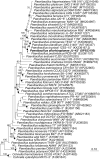Paenibacillus allorhizoplanae sp. nov. from the rhizoplane of a Zea mays root
- PMID: 36115912
- PMCID: PMC9482572
- DOI: 10.1007/s00203-022-03225-w
Paenibacillus allorhizoplanae sp. nov. from the rhizoplane of a Zea mays root
Abstract
A Gram-positive staining, aerobic, endospore-forming bacterial strain, isolated from the rhizosphere of Zea mays was studied for its detailed taxonomic allocation. Based on the 16S rRNA gene sequence similarity comparisons, strain JJ-42 T was shown to be a member of the genus Paenibacillus, most closely related to the type strain of Paenibacillus pectinilyticus (98.8%). The 16S rRNA gene sequence similarity to all other Paenibacillus species was below 98.5%. The pairwise average nucleotide identity (ANI) and digital DNA-DNA hybridization (dDDH) values of the JJ-42 T genome assembly against publicly available Paenibacillus type strain genomes were below 92% and 47%, respectively. The quinone system of strain JJ-42 T consisted exclusively of menaquinone MK-7. The polar lipid profile consisted of the major components diphosphatidylglycerol, phosphatidylethanolamine, phosphatidylglycerol, three aminophospholipids (APL), and one unidentified lipid. The major fatty acids were iso- and anteiso-branched with the major compound anteiso C15:0. Physiological and biochemical characteristics allowed a further phenotypic differentiation of strain JJ-42 T from the most closely related species. Thus, JJ-42 T represents a novel species of the genus Paenibacillus, for which the name Paenibacillus allorhizoplanae sp. nov. is proposed, with JJ-42 T (= LMG 32089 T = CCM 9085 T = DSM 111786 T = CIP 111891 T) as the type strain.
Keywords: Endophyte; Genome sequence; Paenibacillus allorhizoplanae; Plant associated; Taxonomy; Zea mays.
© 2022. The Author(s).
Conflict of interest statement
The authors have no relevant financial or non-financial interests to disclose. The authors declare no competing interests.
Figures


References
MeSH terms
Substances
LinkOut - more resources
Full Text Sources
Molecular Biology Databases

